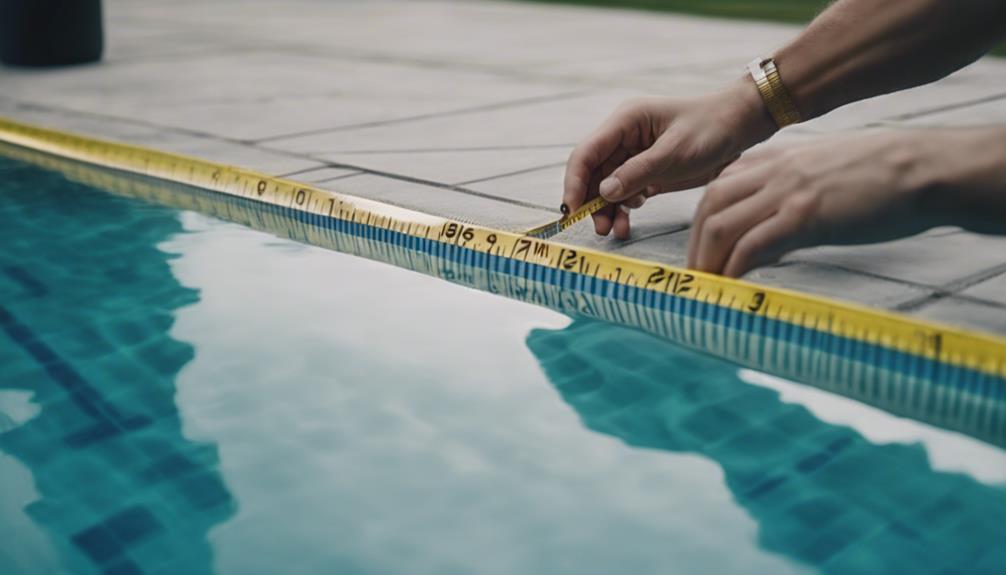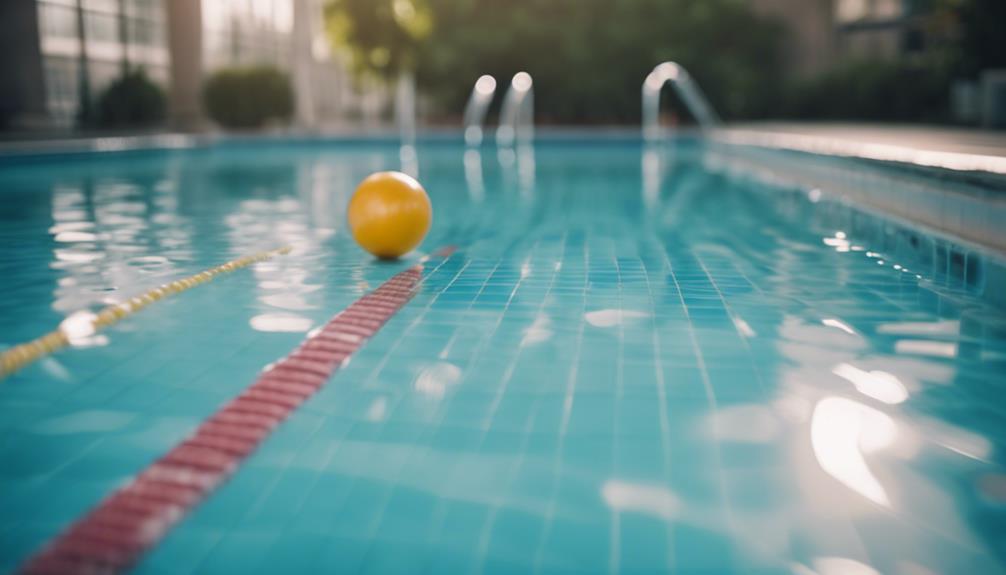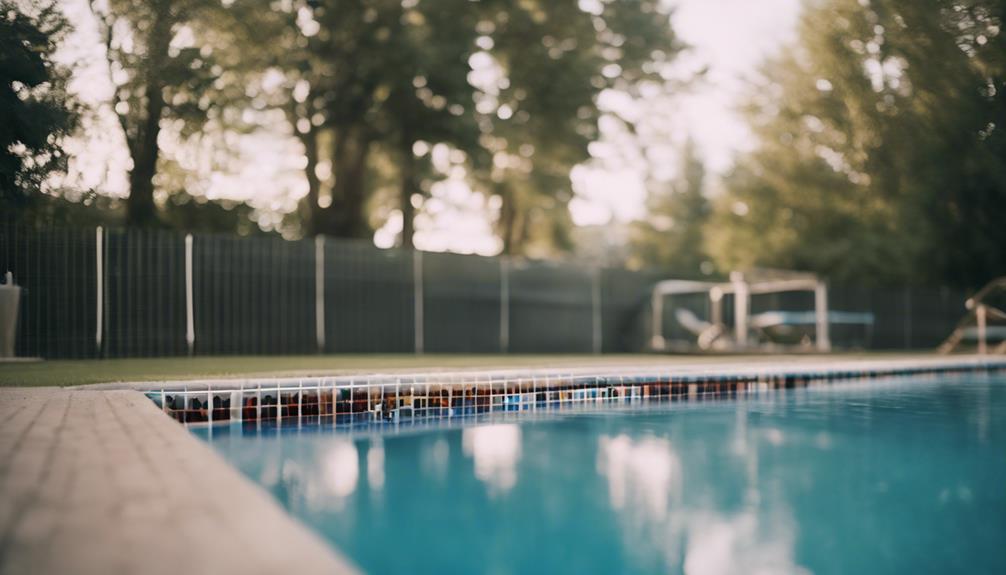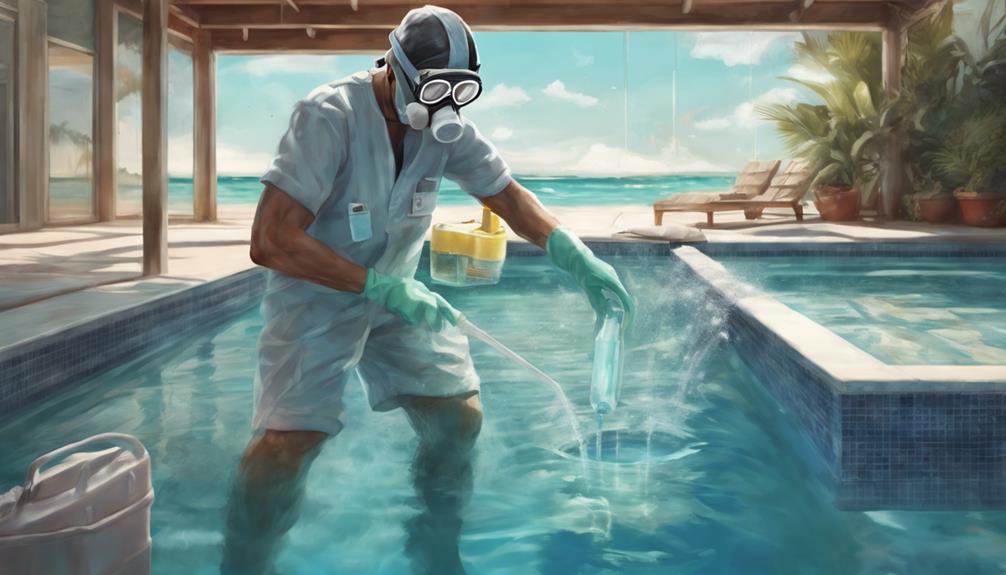To properly determine the size of a swimming pool, you should measure its length and width using a tape measure. If the pool has an irregular shape, divide it into sections to measure separately. For pools with complex shapes, you can use online calculators or pool area formulas. For precise measurements, consider hiring professionals and verifying the measurements. Calculating the surface area helps in accurately dosing chemicals, determining water volume, and estimating maintenance costs. Incorrect measurements can result in incorrect chemical levels, potential damage, and maintenance problems. Regular updates are essential to adapt to changes, maintain chemical balance, and effectively monitor the pool’s health. Continuously exploring different pool measurement methods can improve pool maintenance efficiency.
Key Takeaways
- Use measuring tape for length and width.
- Divide irregular shapes for accurate measurement.
- Utilize online calculators for complex pools.
- Consider professional help for precision.
- Double-check measurements for accuracy.
Pool Shape Selection
Selecting the appropriate pool shape is essential for accurately calculating the surface area. Different pool shapes, such as rectangular, circular, oval, kidney, and irregular, each require specific equations to determine their surface area.
For instance, a kidney-shaped pool necessitates a unique formula for calculation. Understanding the pool shape is important as it directly impacts the method used to calculate the surface area. Rectangular pools, for example, are calculated by multiplying the length by the width, while circular pools utilize the formula π x (radius)^2.
Measurement Determination

To accurately determine the measurements for calculating the surface area of your swimming pool, make sure you have the necessary tools and follow precise guidelines.
The surface area calculation is dependent on the shape of your pool. Round pools require the measurement of the diameter, while rectangular or square pools need both length and width measurements.
It's important to make sure that your estimations are accurate, aligning parallel to the pool edges for accurate area calculation. Proper measurements play a significant role in determining the pool finish, chemical requirements, and system sizing for heating and filtration.
Understanding your pool's shape and dimensions is essential for accurate surface area calculation and effective maintenance planning. By taking careful measurements and following the specific guidelines based on your pool's shape, you can ensure that your calculations are accurate and reliable for maintaining your pool efficiently.
Pool Measurement Process

To accurately calculate the surface area of your swimming pool, start by measuring the length and width for rectangular pools or determine the diameter or radius for circular ones. Make sure to account for the depth of the pool during measurements to guarantee precise results.
Pool Area Calculation
Measure the length and width of your swimming pool to accurately calculate its surface area. To determine the total surface area, follow these steps:
- Rectangular Pools: For rectangular pools, use the formula 2lw + 2lh + 2wh, where l is the length, w is the width, and h is the height of the pool.
- Circular Pools: If you have a circular pool, employ the formula 2πr^2 + 2πrh, with r representing the radius and h denoting the height of the pool.
- Consider Pool Shape: Be mindful of the pool shape; different shapes require specific formulas for accurate surface area calculation.
- Importance of Accuracy: Accurate surface area calculation is crucial for effective pool maintenance, proper chemical dosing, and precise planning for any pool renovations.
Ensuring you use the correct formula based on your pool's shape and measurements will provide you with the precise surface area calculation needed for effective pool management.
Key Measurement Steps
Start by thoroughly evaluating the dimensions of your rectangular pool for accurate surface area calculation. Measure the length and width precisely as these measurements are essential for calculating the total surface area using the formula: 2lw + 2lh + 2wh. Guarantee that each measurement is as precise as possible to avoid errors in the final calculation.
By accurately measuring these dimensions, you set the foundation for an efficient process in determining the surface area of your swimming pool. Remember that the accuracy of your measurements directly impacts the precision of your results.
For circular or oval pools, follow specific formulas considering the diameter or axes measurements accordingly. In the case of irregular pool shapes, break them down into simpler shapes to ensure precise measurements for the overall surface area calculation.
Consistency in measurements and conversion to the same unit are key factors in obtaining accurate results, aiding in proper pool maintenance and renovation planning.
Ensuring Accurate Results
For precise surface area calculations of your swimming pool, ensuring accurate results begins with measuring the depth from the bottom to the top of the wall. To achieve the most accurate measurements, follow these steps:
- Note the depth at both the shallowest and deepest points of the pool. By determining these extremes, you can calculate the average depth, providing a more precise value for your calculations.
- Understand the shape and depth of your pool. Different shapes and depths will require specific calculation methods to guarantee accuracy.
- Guarantee parallel measurements to the pool edges. Consistency in how you measure from the edge of the pool to the depth point is crucial for reliable results.
- Accurate measurements are essential for proper maintenance planning and chemical dosing. Inaccurate measurements could lead to incorrect chemical dosages, affecting the pool's water balance and maintenance needs.
Surface Area Calculation Steps

To accurately calculate the surface area of a swimming pool, make sure that the length and width measurements are in the same unit before applying the appropriate formula for the pool shape. Measure the pool's length and width using a tape measure, ensuring that the dimensions are in feet for accurate results.
For rectangular pools, multiply the length by the width to obtain the square footage. In the case of circular pools, use the formula π x radius squared. It's crucial to convert all measurements to the same unit to prevent errors in your calculations.
Consider utilizing online calculators or tools to streamline the surface area calculation process, especially for complex pool shapes. Remember to update your pool dimensions and surface area calculations regularly to facilitate effective maintenance planning and ensure top-notch pool care.
Depth Measurement Importance

Understanding the importance of pool depth measurement is essential for accurate surface area calculations and effective maintenance planning. Here are four reasons why depth measurement plays an important role in pool maintenance:
- Accurate Surface Area Calculations: Depth measurement is essential for accurately calculating the surface area of a pool, which is important for determining the amount of chemicals needed and heating costs.
- Water Volume Estimation: Knowing the depth helps in estimating the total water volume of the pool, which is critical for proper chemical balance and filtration efficiency.
- Maintenance Planning: Pool depth influences maintenance planning by determining the amount of cleaning chemicals, energy consumption for filtration, and overall upkeep requirements.
- Preventing Over or Underestimation: Accurate depth measurements prevent over or underestimation of pool maintenance needs, ensuring that resources are used efficiently and effectively.
Efficient Pool Maintenance Practices

Regularly monitoring and updating pool surface area measurements is crucial for ensuring effective maintenance practices. By accurately calculating the surface area of your swimming pool, you can efficiently plan the dosing of chemicals and determine the appropriate sizing of equipment.
This precision in maintenance planning not only guarantees the water quality remains at its best but also extends the overall lifespan of your pool. For complex pool shapes, seeking professional assistance can help optimize maintenance practices and ensure accurate measurements.
Additionally, utilizing surface area information enables you to plan and budget effectively for pool renovations and upgrades, enhancing the longevity and functionality of your pool. Remember, accurate measurements are the foundation for efficient pool maintenance practices, enhancing the overall enjoyment and sustainability of your swimming pool.
Frequently Asked Questions
How to Calculate the Surface Area of a Swimming Pool?
To calculate the surface area of a swimming pool, you need the dimensions of the pool.
For rectangular pools, use the formula 2lw + 2lh + 2wh.
Circular pools require 2πr^2 + 2πrh.
Oval pools use πab + (a + b)√((a – b)^2 / 4 + h^2).
Irregular shapes can be divided for simpler calculations.
This accuracy guarantees proper pool maintenance, chemical balance, and equipment suitability, impacting the pool's efficiency and durability.
How to Calculate the Square Footage of a Swimming Pool?
To calculate the square footage of a swimming pool, consider its shape. For rectangular pools, multiply the length by the width.
For circular pools, use the formula πr², where r is the radius.
Oval pools' square footage is found by πab, with a and b as the semi-major and semi-minor axes.
Accurate measurements are crucial for maintenance and renovations. Choose the right formula based on the pool's shape for precise calculations.
How to Calculate Water Surface Area?
To calculate water surface area effectively, measure the pool's length and width accurately. For precise results, select the appropriate formula based on the pool's shape, whether rectangular, circular, oval, or kidney.
Online calculators can streamline this process. Regularly updating pool dimensions is essential for maintenance and chemical dosing accuracy. Understanding the water surface area helps in choosing the right pool cover size and estimating water evaporation.
What Would You Measure the Area of a Swimming Pool In?
When measuring the area of a swimming pool, you'd typically use square feet or square meters as the units. These measurements are vital for various pool-related tasks such as determining the right amount of finish, paint, or tiles needed, calculating chemical requirements accurately, selecting the appropriate pool cover size, estimating water evaporation rates, and managing chemical usage effectively.
Understanding the surface area is essential for maintaining your pool properly and efficiently.
Is the Calculation for Swimming Pool Surface Area Accurate in Both Topics?
When you calculate swimming pool area, make sure to consider the shape and dimensions of the pool. Different shapes require different formulas for accurate measurements. Rectangular pools are straightforward, but irregular shapes like kidney or oval pools need more precise calculations to get an accurate surface area measurement.
Conclusion
To sum up, accurately calculating the surface area of a swimming pool is vital for proper maintenance and chemical balance.
Remember, a pool's shape, measurements, and depth all play an important role in determining the correct surface area.
By following the steps outlined in this article, you can guarantee your measurements are precise and your pool is well-maintained.
As the saying goes, 'measure twice, cut once' – take the time to measure accurately for a clean and healthy swimming pool.










